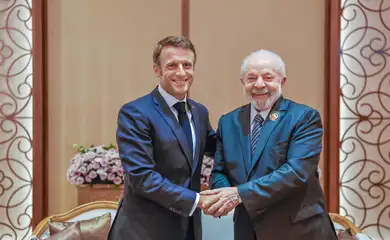Brazil, France launch program to raise €1 bi for bioeconomy in 4 years

The presidents of Brazil, Luiz Inácio Lula da Silva, and France, Emmanuel Macron, in Belém on Tuesday (Mar. 26) launched a program to invest €1 billion in bioeconomy projects for Brazil’s Amazon as well as the section of the Amazon in French Guiana.

The move aims to raise funds through public and private investment in bioeconomy over the next four years. The action comes as part of the Action Plan on the Bioeconomy and the Protection of Tropical Forests, signed by both nations.
At the meeting with the French leader, President Lula called on other nations to contribute to preserving the biome. “We are going to end [deforestation by 2030] in order to prove to the world that we are going to preserve our Amazon. We want to convince the world that the nations that deforested in the past should help the countries that have forests still standing.”
President Macron acknowledged the current Brazilian government’s commitment to preserving the ecosystem. “I am pleased today to see that President Lula is protecting the Amazon. The development of the future of indigenous peoples and biodiversity is not just a question of resistance, it is a cause defended by the federal government itself.” The French president also commented on the €1 billion investment.
“What we want to do is preserve, increase our knowledge, multiply scientific cooperation, build strategies to support indigenous peoples, and have joint investment actions in bioeconomy so it can really grow.”
According to a joint statement released yesterday, the five points of the program that must be observed by the partners are:
- dialogue between the French and Brazilian administrations on the challenges of bioeconomy;
- technical and financial partnership between Brazilian public banks, including the Amazon Bank and the National Bank for Economic and Social Development, in addition to the French Development Agency, present in both Brazil and French Guiana;
- the appointment of special coordinators for the most innovative French and Brazilian companies in bioeconomy;
- a new scientific agreement between France and Brazil, operated by the French Agricultural Research Center for International Development (CIRAD) and the Brazilian Agricultural Research Corporation (Embrapa), which should make it possible to develop new research projects on sustainable sectors, also in French Guiana; and
- the creation of a hub for research, investment, and sharing of technology for bioeconomy, with a focus on building networks of French and Brazilian universities that can contribute to these themes, strengthening the French-Brazilian Center for Amazonian Biodiversity.
Further efforts
In the city of Belém, in addition to the plan on the bioeconomy and protection of tropical forests, the two heads of state also signed another environment-related document: The Brazil–France Call for Climate Ambition from Paris to Belém and Beyond.
“We don’t want to turn the Amazon into a sanctuary for humanity. What we want is to share the exploration and research of our biodiversity wealth with the world,” President Lula said.
The event also saw the launch of a coalition to combat greenwashing in the voluntary carbon market.
The leaders also intend to finalize negotiations on Article 6 of the Paris Agreement by the 2024 United Nations Climate Change Conference (COP29) in Baku, Azerbaijan. The aim is to establish a regulated, efficient, and transparent carbon market.
Bioeconomy
Bioeconomy in the Amazon is seen as a major driver of sustainable development in the region, both economically and socially. The model adopts the rational use of renewable natural resources, forest conservation, and the sustainable production of goods, energy, and other resources.



